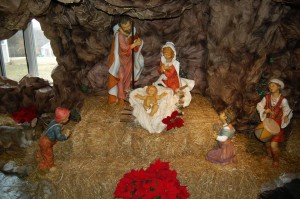There’s no need to read a psychology book to realize that men and women are different—often very different, especially how they think. Our daily social encounters confirm it.
 On New Year’s Day, we (the students of Immaculate Conception Academy) went to Mater Ecclesiae College for their choir concert, Christmas Room viewing, and for dinner. After listening to the angelic voices of the Mater Ecclesiae choir, we entered the Christmas Room. A sophomore at the college explained the symbolism of the Christmas Room, a journey through salvation history, beginning with God’s covenant with Abraham and ending with the scene of the Nativity.
On New Year’s Day, we (the students of Immaculate Conception Academy) went to Mater Ecclesiae College for their choir concert, Christmas Room viewing, and for dinner. After listening to the angelic voices of the Mater Ecclesiae choir, we entered the Christmas Room. A sophomore at the college explained the symbolism of the Christmas Room, a journey through salvation history, beginning with God’s covenant with Abraham and ending with the scene of the Nativity.
“Wow,” I thought to myself, “the symbolism itself must have taken a lot of thought, not to mention actually portraying it all in a single room.”
The next day, I had the chance to see Br Robert Antonio, LC (my biological brother), in Thornwood, NY while I was there for a presentation with two lay consecrated and another precandidate. After the presentation concluded and while the others were engaged in conversation, I talked with Br Robert.
“You know,” I told him, “we’re really looking forward to seeing the Christmas room. Could you show it to us?”
“Sure,” he quickly replied.
“Yesterday, we saw the one the consecrated at Mater Ecclesiae made. It was amazing! It symbolized salvation history, from Abraham to the birth of Jesus.” I was almost hoping he would say something about the Thornwood Christmas Room to match this.
“Oh, well wait until you see ours. It’s very…philosophical.”
Soon after, we went to see it. The “brick” pillars immediately caught our attention. “Wow, I wonder how they made these,” we said to each other, thinking of our own simple Christmas corner at ICA. We continued viewing it from left to right: first, the impeccable stain-glass windows of the before-Nativity events; then, a chalk painting of the angel’s apparition to the shepherds; and finally, the Nativity. We took a moment to admire it, looking at the figurines, the stable-like structure, and the roof covered in hay and sticks. For a second, I felt like I was transported back in time, gazing upon the scene Jesus’ birth.
Then we moved to the right of the Nativity scene. This caught us by surprise. Immediately adjacent to the Nativity, we peered into a “hole” in a “brick wall”. It was a small room with a blue armchair in it. On its seat, sat a toppled over stuffed puppy. To the side of the chair was a small table with a lamp and on the floor was a little rug. The picture-perfect 20th century room seemed more appropriate for a life-size dollhouse, not a Christmas room created by seminarians and priests.
“So what’s this,” we asked my brother.
“What does it look like?” Br. Robert replied in a tone of ponderous thought, seemingly trying to evoke a similar depth of thought from all of us.
I thought to myself, “this must be where the philosophical symbolism he was telling me about earlier is.”
“A room,” one of us replied to the question.
“That’s it!” he replied in a surprisingly almost excited voice. “It’s a Christmas (motioning to the Nativity on the left) Room (motioning to the little room in front of us).”
Just thinking about it makes me laugh. I can’t help but contrast the delicate Christmas room of Mater Ecclesiae with it’s symbolism of salvation history to the extensive artistry of the Christmas room of the seminary at Thornwood with its Christmas—Room. I don’t doubt that there was more symbolism in the Thornwood Christmas Room than what we learned from my brother. However, for purposes of contrast, this simple observation shows that, yes, men and women are very different.
